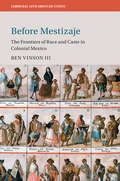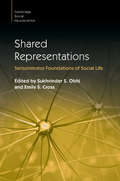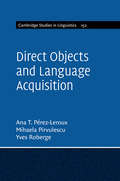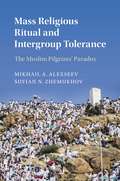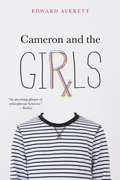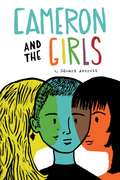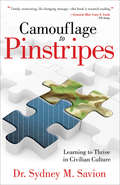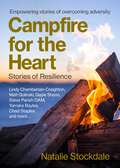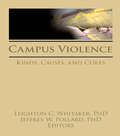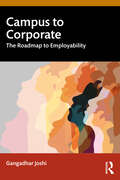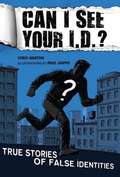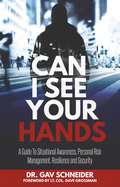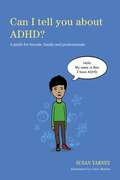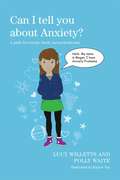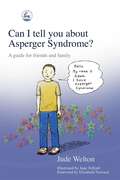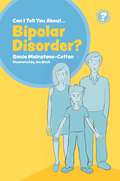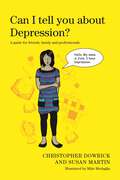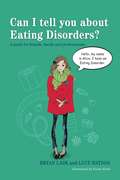- Table View
- List View
Cambridge Latin American Studies: Before Mestizaje
by Ben Vinson IIIThis book opens new dimensions on race in Latin America by examining the extreme caste groups of colonial Mexico. In tracing their experiences, a broader understanding of the connection between mestizaje (Latin America's modern ideology of racial mixture) and the colonial caste system is rendered. Before mestizaje emerged as a primary concept in Latin America, an earlier precursor existed that must be taken seriously. This colonial form of racial hybridity, encased in an elastic caste system, allowed some people to live through multiple racial lives. Hence, the great fusion of races that swept Latin America and defined its modernity, carries an important corollary. Mestizaje, when viewed at its roots, is not just about mixture, but also about dissecting and reconnecting lives. Such experiences may have carved a special ability for some Latin American populations to reach across racial groups to relate with and understand multiple racial perspectives. This overlooked, deep history of mestizaje is a legacy that can be built upon in modern times.
Cambridge Military Histories: Morale and the Italian Army during the First World War
by Vanda WilcoxItalian performance in the First World War has been generally disparaged or ignored compared to that of the armies on the Western Front, and troop morale in particular has been seen as a major weakness of the Italian army. In this first book-length study of Italian morale in any language, Vanda Wilcox reassesses Italian policy and performance from the perspective both of the army as an institution and of the ordinary soldiers who found themselves fighting a brutally hard war. Wilcox analyses and contextualises Italy's notoriously hard military discipline along with leadership, training methods and logistics before considering the reactions of the troops and tracing the interactions between institutions and individuals. Restoring historical agency to soldiers often considered passive and indifferent, Wilcox illustrates how and why Italians complied, endured or resisted the army's demands through balancing their civilian and military identities.
Cambridge Social Neuroscience: Shared Representations
by Cross Obhi Sukhvinder S. Emily S.Socially situated thought and behaviour are pervasive and vitally important in human society. The social brain has become a focus of study for researchers in the neurosciences, psychology, biology and other areas of behavioural science, and it is becoming increasingly clear that social behaviour is heavily dependent on shared representations. Any social activity, from a simple conversation to a well-drilled military exercise to an exquisitely perfected dance routine, involves information sharing between the brains of those involved. This volume comprises a collection of cutting-edge essays centred on the idea of shared representations, broadly defined. Featuring contributions from established world leaders in their fields and written in a simultaneously accessible and detailed style, this is an invaluable resource for established researchers and those who are new to the field.
Cambridge Studies in Biological and Evolutionary Anthropology: Demography and Evolutionary Ecology of Hadza Hunter-Gatherers
by Nicholas Blurton JonesThe Hadza, an ethnic group indigenous to northern Tanzania, are one of the few remaining hunter-gatherer populations. Archaeology shows 130,000 years of hunting and gathering in their land but Hadza are rapidly losing areas vital to their way of life. This book offers a unique opportunity to capture a disappearing lifestyle. Blurton Jones interweaves data from ecology, demography and evolutionary ecology to present a comprehensive analysis of the Hadza foragers. Discussion centres on expansion of the adaptationist perspective beyond topics customarily studied in human behavioural ecology, to interpret a wider range of anthropological concepts. Analysing behavioural aspects, with a specific focus on relationships and their wider impact on the population, this book reports the demographic consequences of different patterns of marriage and the availability of helpers such as husbands, children, and grandmothers. Essential for researchers and graduate students alike, this book will challenge preconceptions of human sociobiology.
Cambridge Studies in Law and Society: Buried in the Heart
by Erin BainesIn Buried in the Heart, Erin Baines explores the political agency of women abducted as children by the Lord's Resistance Army in northern Uganda, forced to marry its commanders, and to bear their children. Introducing the concept of complex victimhood, she argues that abducted women were not passive victims, but navigated complex social and political worlds that were life inside the violent armed group. Exploring the life stories of thirty women, Baines considers the possibilities of storytelling to reclaim one's sense of self and relations to others, and to generate political judgement after mass violence. Buried in the Heart moves beyond victim and perpetrator frameworks prevalent in the field of transitional justice, shifting the attention to stories of living through mass violence and the possibilities of remaking communities after it. The book contributes to an overlooked aspect of international justice: women's political agency during wartime.
Cambridge Studies in Linguistics: Direct Objects and Language Acquisition (Cambridge Studies in Linguistics #152)
by Pérez-Leroux Ana T. Mihaela Pirvulescu Yves RobergeDirect object omission is a general occurrence, observed in varying degrees across the world's languages. The expression of verbal transitivity in small children begins with the regular use of verbs without their object, even where object omissions are illicit in the ambient language. Grounded in generative grammar and learnability theory, this book presents a comprehensive view of experimental approaches to object acquisition, and is the first to examine how children rely on the lexical, structural and pragmatic components to unravel the system. The results presented lead to the hypothesis that missing objects in child language should not be seen as a deficit but as a continuous process of knowledge integration. The book argues for a new model of how this aspect of grammar is innately represented from birth. Ideal reading for advanced students and researchers in language acquisition and syntactic theory, the book's opening and closing chapters are also suitable for non-specialist readers.
Cambridge Studies in Religion, Philosophy, and Society: Psychology, Religion, and Spirituality
by Fraser WattsPsychology, Religion, and Spirituality provides readers with a critical overview of what psychology tells us about religion and spirituality. It is concise without being simplistic, and the first such broad overview to be published for some years. Fraser Watts recognizes that 'religion' is complex and multi-faceted, taking different forms in different people and contexts. The book presents a broad view of psychology; whatever kind of psychology you are interested in, you will find it covered here, from biological to social, and from experimental to psychoanalytic. It focuses particularly on the varied concepts that psychologists have employed to make sense of religion and subjects them to critical examination. The book is also concerned with practical applications, helping those engaged in religious ministry. It will be of interest to undergraduates and general readers, as well as specialists in religious studies, psychology, and philosophy of religion.
Cambridge Studies in Social Theory, Religion, and Politics: The Muslim Pilgrims' Paradox (Cambridge Studies in Social Theory, Religion and Politics)
by Alexseev Mikhail A. Zhemukhov Sufian N.Under what conditions does in-group pride facilitate out-group tolerance? What are the causal linkages between intergroup tolerance and socialization in religious rituals? This book examines how Muslims from Russia's North Caucuses returned from the Hajj pilgrimage to Mecca both more devout as Muslims and more tolerant of out-groups. Drawing on prominent theories of identity and social capital, the authors resolve seeming contradictions between the two literatures by showing the effects of religious rituals that highlight within-group diversity at the same time that they affirm the group's common identity. This theory is then applied to explain why social integration of Muslim immigrants has been more successful in the USA than in Europe and how the largest Hispanic association in the US defied the clash of civilizations theory by promoting immigrants' integration into America's social mainstream. The book offers insights into Islam's role in society and politics and the interrelationships between religious faith, immigration and ethnic identity, and tolerance that will be relevant to both scholars and practitioners.
Cameron And The Girls
by Edward Averett"Mad crashes into happy and sad bounces off of guilty until they all live in a big smoky heap in my mind." Fourteen-year-old Cameron Galloway of Lexington, Washington, understands that he has schizophreniform disorder and needs to take pills to quiet the voices in his head. But he likes the voices, especially the gentle, encouraging voice of The Girl. Conflicted, he turns to his friend Nina Savage, who is clinically depressed and can relate to his horror of the numbing effects of medication. They make a pact to ditch the pills. At first they feel triumphant, but soon Cameron's untreated mind goes haywire--to disastrous effect.and a young man at the center of it all, desperately trying to find his way into adulthood.
Cameron and the Girls
by Edward Averett<P>"Mad crashes into happy and sad bounces off of guilty until they all live in a big smoky heap in my mind." <P>Fourteen-year-old Cameron Galloway of Lexington, Washington, understands that he has schizophreniform disorder and needs to take pills to quiet the voices in his head. But he likes the voices, especially the gentle, encouraging voice of The Girl. <P>Conflicted, he turns to his friend Nina Savage, who is clinically depressed and can relate to his horror of the numbing effects of medication. They make a pact to ditch the pills. At first they feel triumphant, but soon Cameron's untreated mind goes haywire--to disastrous effect and a young man at the center of it all, desperately trying to find his way into adulthood.
Camouflage to Pinstripes: Learning to Thrive in Civilian Culture (Camouflage To Pinstripes Ser.)
by Sydney M. SavionThis practical guide offers essential advice for veterans who face mental and emotional challenges as they transition back to civilian life.Leaving the military can be a major life change. In Camouflage to Pinstripes, Dr. Sydney M. Savion examines the psychological process veterans face as they reassimilate to civilian culture. Combining academic research and voices of experience, this book shepherds readers through the process of navigating changes in culture, identity, awareness, and self-renewal.Camouflage to Pinstripes will help individuals make the most of their transition to civilian life by leveraging lessons learned from others. It is about much more than doffing a uniform and donning a suit; it is a gradual journey of surrendering a beloved lifestyle and profession and thriving in a new culture.
Campfire for the Heart: Stories of Resilience
by Natalie StockdaleDo you ever wonder…. how other people cope with trauma, grief and tragedy? how other people rise from their lows? how other people find peace after pain? Campfire for the Heart answers these questions through powerful and compelling, true stories of human resilience. By learning how other people have converted their darkest times to personal growth and success, you may discover how you too can learn and grow from your hardships, how you can be the hero of your journey, or help others in theirs. The stories cover a vast range of life experiences from the death of children, violence, Taliban terror and wrongful imprisonment, to droughts, bushfires, cyclones, diseases, injuries, disabilities and trauma from military, police and humanitarian work. The storytellers are mostly unknown heroes of their personal journeys, while others are well-known champions of resilience – Lindy Chamberlain-Creighton, celebrity chef Matt Golinski, Steve Parish OAM and Gayle Shann – while cave-diving legend and Co-Australian of the Year 2019, Dr Craig Challen, opens the book with a foreword.The &‘campfire&’ stories are beyond inspiring. They stretch your perception of resilience, restore your love of humanity and illuminate pathways to happiness for us all.
Campus Violence: Kinds, Causes, and Cures
by Leighton Whitaker Jeffrey PollardThis timely book shows how the rapidly increasing phenomenon of violence in the U.S. is invading college and university campuses. Campus Violence shows what colleges, universities, and other schools can do to deconstruct the violence culture and begin to educate for a better society. The chapters assist educators in determining the nature of both external and internal violence and what to do about it. Readers will benefit from the experiences of many institutions of higher learning as communicated by various outstanding contributors to this book. By becoming sharply aware of the issues and solutions, administrators may engage in better, more realistic long-range planning, as well as get help for the myriad daily questions and problems inherent to running today’s campuses.As a whole, the book is devoted to highlighting important kinds, causes, and cures of violence destructive to living and learning opportunities. The contributors address the full range of issues from conceptualization to practical ways of handling violent behaviors. Section I: Addresses the broadest, most far-reaching views of campus violence: the conceptualization of campus violence, administration perspectives, the destructive concoction of alcohol and other drugs and morbidity, and the commercial promotion of mindless violence. Section II: Addresses specific kinds of violence. Section III: Focuses on the most frequent immediate perpetrators--male college students--and how their behavior can be dealt with and improved. Section IV: Focuses very specifically on how the college counselor or psychotherapist can be a consultant to staff and faculty in regard to disruptive students.Campus Violence depicts the need to nurture and develop atmospheres for learning, respect, and constructive action--arguably the most pressing topic in education today. Counselors, therapists, security officers, deans, and presidents can begin to counter the rapidly increasing phenomenon of violence in American colleges and universities and cultivate a positive leadership atmosphere. The implications of the contributing authors reach to the primary and secondary schools in our nation--the training grounds for college life and education--and provoke some questions which begin to create a better learning environment.
Campus to Corporate: The Roadmap to Employability
by Gangadhar JoshiThis book offers a fresh perspective on the techniques of coping with the challenges of transitioning from student life to a professional corporate environment. It presents an integrated approach and a workable plan for students to pursue and add value to their careers by developing life and business skills that could be seamlessly woven into a well-rounded personality.This book has been designed to help students stand out in terms of knowledge, skills and attitude. It delineates the transition needs (from classrooms to workplace) with clearly defined end results, imparting skills required to excel individually and as part of a team, as a matter of regular practise while working in the corporate world.The primary aim of this book is not just to place graduates in the corporate world but also to enhance their employability skills to make them globally employable in diverse disciplines. Replete with easy-to-use tips and tools with real-world applications, this book will be of immense value to final year graduates and post-graduate students, as well as placement officers of higher education institutions looking to achieve a good placement record.
Can Christianity Cure Obsessive-compulsive Disorder?: A Psychiatrist Explores The Role Of Faith In Treatment
by Ian OsbornObsessive-compulsive disorder (OCD) is a relentless condition, the primary symptom being the occurrence of terrifying ideas, images, and urges that jump into a person's mind and return again and again, despite the individual's attempt to remove them. Christians who suffer from OCD may grapple with additional guilt, as the undesired thoughts are frequently of a spiritual nature. Yet people may be surprised to learn that some of the greatest leaders in Christian history also struggled with this malady. What did they experience? How did they cope? Were they able to overcome these tormenting, often violent, obsessions? Where did God fit into the picture? Ian Osborn shares the personal accounts of Martin Luther, John Bunyan, and Saint Thérèse of Lisieux, as well as his own story, in exploring how faith and science work together to address this complex issue.
Can Fish Count?: What Animals Reveal About Our Uniquely Mathematical Minds
by Brian ButterworthAn entertaining investigation of the numerical abilities of animals and our own appetite for arithmetic The philosopher Bertrand Russell once observed that realizing that a pair of apples and the passage of two days could somehow both be represented by the concept we call &“two&” was one of the most astonishing discoveries anyone had ever made. So what do we make of the incredible fact that animals seem to have inherent mathematical abilities? As cognitive psychologist Brian Butterworth shows us in Can Fish Count?, many &“simple&” animals—such as bees, which count trees and fence posts, and guppies, which can size up groups—have a sense of numbers. And unlike humans, they don&’t need to be taught. In telling animals&’ stories, Butterworth shines new light on one of our most ancient questions: Just where, exactly, do numbers come from? He reveals how insights gleaned from studying animals can help us make better sense of our own abilities. Full of discovery and delight, Can Fish Count? is an astonishing journey through the animal kingdom and the human mind.
Can I See Your I.D.?: True Stories of False Identities
by Paul Barton Chris HoppeTrue crime, desperation, fraud, and adventure: From the impoverished young woman who enchanted nineteenth-century British society as a faux Asian princess, to the sixteen-year-old boy who "stole" a subway train in 1993, to the lonely but clever Frank Abagnale of Catch Me if You Can fame, these ten vignettes offer riveting insight into mind-blowing masquerades. Graphic panels draw you into the exploits of these pretenders, and meticulously researched details keep you on the edge of your seat. Each scene is presented in the second person, a unique point of view that literally places you inside the faker's mind. With motivations that include survival, delusion, and plain, old-fashioned greed, the psychology of deception has never been so fascinating or so close at hand.
Can I See your Hands: A Guide To Situational Awareness, Personal Risk Management, Resilience and Security
by Gavriel SchneiderThe title of this book: CAN I SEE YOUR HANDS refers to one of the key outcomes of this book-- being able to tell whether or not people want to cause us harm. To put it very simply, if you can see someone's hands and they are not concealing them, holding a weapon or positioning to strike you, one's levels of trust and confidence can increase. This simple example can serve as a reminder to all of us in many of the complex moments we have to deal with, and difficult decisions we have to make, in everyday life.
Can I Tell You About Self-Harm?: A Guide for Friends, Family and Professionals
by Pooky Knightsmith Elise Evans Jonathan SingerMeet Asher - a teenager who self-harms to manage their feelings when it all feels like too much. The latest in the best-selling Can I Tell You About... series describes what self-harm is, along with the wide range of behaviours that qualify, why teens do it, and how to get help if you feel the need to self-harm. Reflecting on the different aspects of self-harming behaviour, including treatment of injuries and scars, this concise introduction dispels common myths and offers helpful resources to break the cycle of self-harm. By initiating the conversation around self-harm, this guide will offer alternative avenues for children and young adults to pursue when dealing with big feelings, such as professional counselling, distraction, and friends and family. This easy-to-read guide is suitable for readers 7+, along with their parents, teachers, and friends. All author royalties from the book will go towards the Charlie Waller Memorial Trust.
Can I tell you about ADHD?: A guide for friends, family and professionals
by Chris Martin Susan YarneyMeet Ben - a young boy with ADHD. Ben invites readers to learn about ADHD from his perspective. He helps children understand what it means to have ADHD and describes what it is and how it feels. Ben explains how he was diagnosed and what he has learnt about ways to relieve his ADHD symptoms, and how friends and adults can help at home and school. This illustrated book is full of useful information and will be an ideal introduction for young people, aged 7 upwards, as well as parents, friends, teachers and professionals working with children with ADHD. It is also an excellent starting point for family and classroom discussions.
Can I tell you about Anxiety?: A guide for friends, family and professionals
by Polly Waite Kaiyee Tay Lucy WillettsMeet Megan - a young girl who has an anxiety disorder. Megan invites readers to learn about anxiety from her perspective, helping them to understand why she sometimes feels anxious and how this affects her thoughts, feelings and behaviours. Megan talks about techniques she has learnt to help manage her anxiety, and how people around her can help. With illustrations throughout, this will be an ideal way to explore anxiety difficulties. It shows family, friends and teachers how they can support someone who experiences anxiety and will be an excellent way to start a conversation about anxiety, in the classroom or at home.
Can I tell you about Asperger Syndrome?: A guide for friends and family
by Jude Welton Jane Telford Elizabeth NewsonMeet Adam - a young boy with AS. Adam invites young readers to learn about AS from his perspective. He helps children understand the difficulties faced by a child with AS - he tells them what AS is, what it feels like to have AS and how they can help children with AS by understanding their differences and appreciating their many talents. This illustrated book is ideally suited for boys and girls between 7 and 15 years old and also serves as an excellent starting point for family and classroom discussions.
Can I tell you about Bipolar Disorder?: A Guide For Friends, Family And Professionals (Can I Tell You About... ? Ser.)
by Sonia Mainstone-Cotton Jon BirchIf a grownup you love has bipolar disorder, what does that mean? In this friendly guide, 11-year-old Josh tells all about his dad's bipolar, including what mental illness is, and how it can affect patients and their families. The guide explains in child-friendly terms how different types of bipolar affect people's feelings and behaviour. It is a comforting book that prepares young readers for the hard parts of knowing someone with bipolar, while communicating that bipolar is nothing to be afraid or ashamed of. Providing an excellent starting point for discussion both at home and in the classroom, it also includes a helpful list of recommended sources for additional support.
Can I tell you about Depression?: A guide for friends, family and professionals
by Susan Martin Christopher Dowrick Mike MedagliaPart of the Reading Well scheme. 35 books selected by young people and health professionals to provide 13 to 18 year olds with high-quality support, information and advice about common mental health issues and related conditions. Meet Julie - a women who suffers from periods of depression. Julie and her family help readers to understand what depression is, what it is like to feel depressed and how it can affect their family life. She explains how coping with depression can sometimes be very difficult but there is support and help available that can relieve the feelings of depression. This illustrated book is an ideal introduction to depression - a condition that can be particularly difficult for children to understand. It is suitable for readers aged 7 upwards and shows family, friends and anyone who knows someone affected by depression how they can offer support.
Can I tell you about Eating Disorders?: A guide for friends, family and professionals
by Bryan Lask Fiona Field Lucy WatsonPart of the Reading Well scheme. 35 books selected by young people and health professionals to provide 13 to 18 year olds with high-quality support, information and advice about common mental health issues and related conditions. Meet Alice - a teenage girl with anorexia nervosa. Alice invites readers to learn about anorexia nervosa and how it makes her see herself differently from how other people see her. She also introduces readers to Beth who has bulimia nervosa, Sam who has selective eating problems, Francesca who has functional dysphagia and Freddie who has food avoidance emotional disorder. They all explain why they find food difficult and how their eating disorders are different. This illustrated book is an ideal introduction to understanding the complex issues surrounding eating disorders. It shows family, friends and teachers how they can support a young person with an eating disorder and will also be a good place to start when encouraging open conversations about eating disorders at school or at home.
